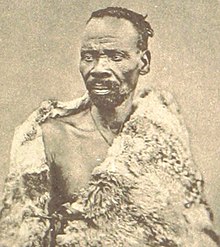
Back Sekhukhune Afrikaans Sekhukhune German Sekhukhune Ier French Sekhukhune Dutch Matsebe Sekhukhune NSO Sekhukhuni Siswati Секукуне I Ukrainian
| Sekhukhune I | |
|---|---|
 | |
| King of the Bapedi | |
| Reign | 21 September 1861 – 13 August 1882 |
| Predecessor | Sekwati I |
| Successor | Kgoloko (regent for Sekhukhune II) |
| Born | Matsebe Unknown date, 1814 |
| Died | (aged 68) |
| Spouse | Legoadi IV |
| Issue | Morwamotshe II |
| House | Maroteng |
| Father | Sekwati I |
| Mother | Thorometjane Phala |
| Religion | African Traditional Religion |
Sekhukhune I[a] [b](Matsebe; circa 1814 – 13 August 1882) was the paramount King of the Marota, more commonly known as the Bapedi (Pedi people), from 21 September 1861 until his assassination on 13 August 1882 by his rival and half-brother, Mampuru II.[1] As the Pedi paramount leader he was faced with political challenges from Voortrekkers (Boer settlers), the independent South African Republic (Dutch: Zuid-Afrikaansche Republiek), the British Empire, and considerable social change caused by Christian missionaries.
Following the death of his father, King Sekwati, on 20 September 1861, Sekhukhune successfully defended his right to the throne against his half-brother Mampuru II and heir apparent with the support of his Matuba regiment. Despite his victory, Sekhukhune adhered to the serota tradition and allowed Mampuru to peacefully leave the Bapedi territory. His other known siblings were; Legolwana,[2] Johannes Dinkwanyane, and Kgoloko.[3] Sekhukhune married Legoadi IV in 1862, and lived on a mountain, now known as Thaba Leolo or Leolo Mountains,[4] which he fortified. To strengthen his kingdom and guard against European colonization, he had his young subjects work in white mines and on farms so that their salaries could be used to buy guns from the Portuguese in Delagoa Bay, as well as livestock.

Sekhukhune fought two notable wars. The first war was successfully fought in 1876, against the ZAR and their Swazi allies. The second war, against the British and Swazi in 1879 in what became known as the Sekhukhune Wars, was less successful.[5][6]
Sekhukhune was detained in Pretoria until 1881. After a return to his kingdom, he was fatally stabbed by an assassin (Mampuru II and his henchmen) in 1882, at Manoge.[7] The assassins are presumed to have been sent by his brother and competitor, Mampuru II.[8][9]
Cite error: There are <ref group=lower-alpha> tags or {{efn}} templates on this page, but the references will not show without a {{reflist|group=lower-alpha}} template or {{notelist}} template (see the help page).
- ^ "Freedom Park - Lest We Forget! - King Sekhukhune". www.freedompark.co.za. Retrieved 2023-07-26.
- ^ "THE SEKUKUNI WARS PART II - South African Military History Society - Journal". samilitaryhistory.org. Retrieved 2020-09-04.
- ^ "Bapedi Marote Mamone v Commission on Traditional Leadership Disputes and Claims and Others (40404/2008) [2012] ZAGPPHC 209; [2012] 4 All SA 544 (GNP) (21 September 2012)". www.saflii.org. Retrieved 2020-09-04.
- ^ Du Plessis, E. J. (1973). 'n Ondersoek na die oorsprong en betekenis van Suid-Afrikaanse berg- en riviername: 'n histories-taalkundige studie [An Investigation into the origin and meaning of South African mountain and river names: a historico-linguistic study] (in Afrikaans). Cape Town: Tafelberg. p. 187. ISBN 978-0-624-00273-4.
- ^ "King Sekhukhune". South African History Online. 13 February 2018. Retrieved 4 March 2019.
- ^ Kinsey, H.W. (June 1973). "The Sekukuni Wars". Military History Journal. 2 (5). The South African Military History Society.
- ^ "Bapedi Marote Mamone v Commission on Traditional Leadership Disputes and Claims and Others (40404/2008) [2012] ZAGPPHC 209; [2012] 4 All SA 544 (GNP) (21 September 2012)". www.saflii.org. Retrieved 2020-08-08.
- ^ Delius, Peter (1984). The land belongs to us: the Pedi polity, the Boers and the British in the nineteenth-century Transvaal. Heinemann. pp. 251–252. ISBN 978-0-435-94050-8.
- ^ Delius, Peter; Rüther, Kirsten (2013). "The King, the Missionary and the Missionary's Daughter". Journal of Southern African Studies. 39 (3): 597–614. doi:10.1080/03057070.2013.824769. S2CID 143487212.